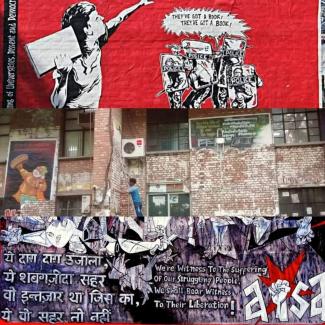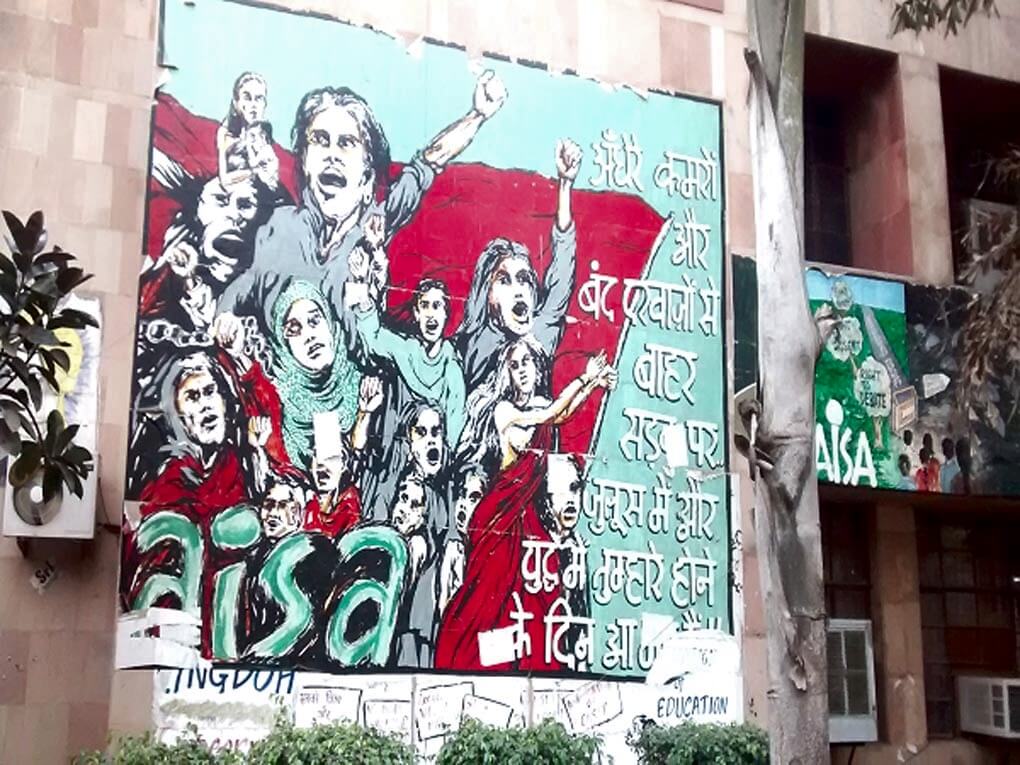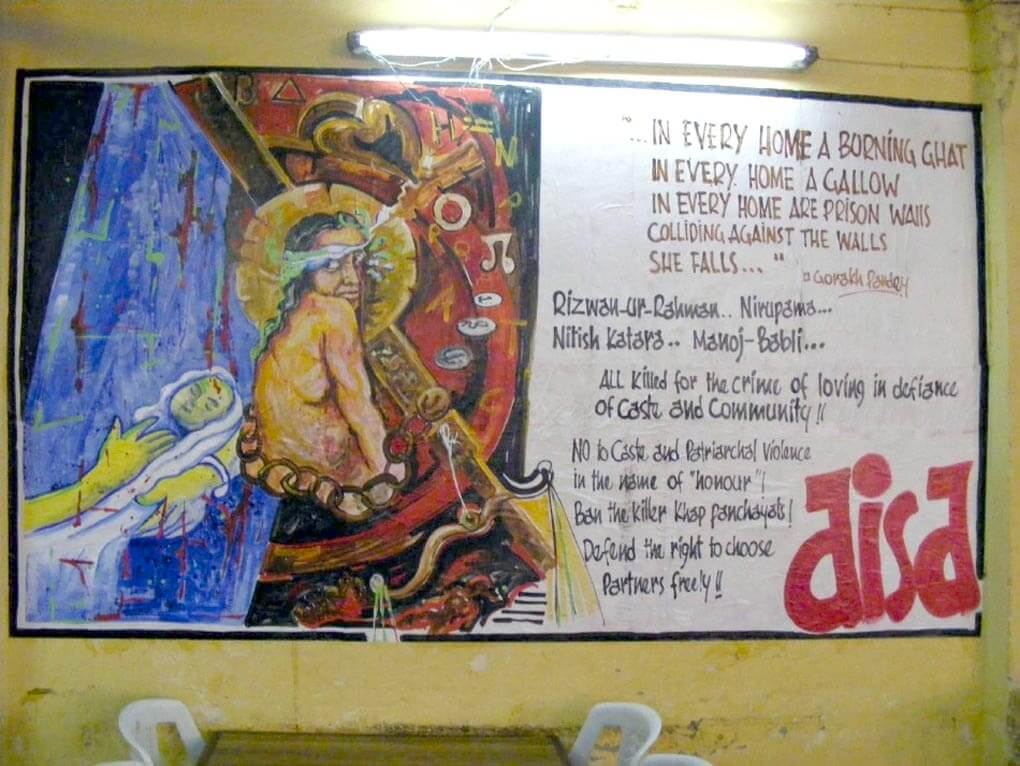
The walls of the JNU writes this letter.
The walls that, as Eduardo Galeano said, have always been the “publishers of the poor.”
Today, these walls are being made barren and devoid of any language and grammar to communicate with students.
These walls are libraries of street, they are symbols of resistance, they are canvas for artists to portray a world filled with inequality, injustice and oppression through art, words, poems and paintings.
These walls are spaces of democracy, academics and art as they speak, debate and dissent with other walls, posters, paintings, students, teachers, workers, administration, government, nature, economy, foreign policy and the world outside on every issue and subject.
For decades, these walls have communicated with visiting ambassadors, high commissioners, bureaucrats, professors, politicians, head of the state and whose who of the world. These walls of JNU aren’t just walls but they are spaces of learning, they are platforms for ideological debates and they represent a unique but powerful expression of our constitutional and democratic freedom.
The walls whose art gets widely covered in the national and international media and that which forms the base of many thesis and dissertations. This shows how the state trembles at truth, if spoken – especially through walls meant for voices of the streets and the masses. These fascists fear the walls of JNU because they represent ideas that build India; the ideas of justice, equality and liberty, and a society free of oppression.

These walls mirrors the society filled with inequality, oppression and injustice. They are a canvas and a paradise for the poor. They are a canvas to paint their pain and suffering, and paradise to learn, educate and fight back the injustice.
Mandela, Ambedkar, Periyar, Savitri Bai Phule, Marx, Ashfaqullah, Rosa Luxemberg, Lenin and many others whose books and ideas have been bundled and stored inside libraries spoke to them. These walls unpacked their ideas, brought them closer to the people on streets; they made the masses to understand the essence to resist and cherish the resistance.
They were yesteryear’s social media for youngsters that brought out their creativity and gave them the freedom from fear to speak their mind through art, words and paintings. However the way social media has been taken over by trolls of the fascists, who wait to hound, today the government and the university administration are taking down the wall posters of the university.
Mamidala Jagadesh Kumar, the vice chancellor (VC), says that the university has adopted Delhi Defacement Act and therefore these ideas, posters, painting and walls itself are a “defacement”.
Mr VC, please tell me – “Is speaking about Bhagat Singh “defacement” in a university? Is learning annihilation of caste from the walls “defacement” ? Is experience of women like Rosa Luxemberg, Savitribai and others who are speaking through the walls of JNU “defacement” ? Is preaching rationality that is the essence of Indian constitution by Periyar who is standing tall on JNU’s wall “defacement” ? Or is writing and painting about the legacy of Birsa Munda whose life is a celebration for anyone and everyone who fights for tribals and forest rights a “defacement”?”
At a time, when tribals have been butchered in Sonbhadra and Uttar Pradesh for defending their land, shouldn’t the walls be roaring in their defence? or do you want to silence the voice on the wall as “defacement”?
Mr VC, you have imposed 80% budget cut on JNU’s library and now you want the libraries of the street to be vanquished through force calling them “defacement”. The walls of JNU would like to ask you – will a library filled with books with blank pages make any sense?
Students of JNU will resist this “defacement” of ideas. They will march and paint those walls with truth. They will resist the fake news peddled through whatsapp, by these walls: not barren but filled with ideas, words and art of young minds who wish to change the world in order to make it equal, just and free of oppression.

The walls of JNU showed students the condition of workers in Latin America who were exploited and killed to mine silver and gold. These walls decorated millions of individuals who died fighting against colonialism in Africa, India and other parts of the world. They narrated how today’s imperial powers are replicating the same with neoliberal policies and capitalism.
It is important to remember what Ambedkar said (see Ambedkar, Writings And Speeches: A Ready Reference Manual):
“Freedom of mind is the real freedom.
A person whose mind is not free though he may not be in chains, is a slave, not a free man.
One whose mind is not free, though he may not be in prison, is a prisoner and not a free man.
One whose mind is not free though alive, is no better than dead.
Freedom of mind is the proof of one’s existence.”
It is this freedom that the walls of JNU represent and it is for this freedom that students are fighting for.
Till then the Walls of Revolution Live!
Viva Revolution!
Inquilab Zindabad!
Liberation Archive
- 2001-2010
-
2011-2020
- 2011
- 2012
- 2013
- 2014
- 2015
- 2016
- 2017
- 2018
-
2019
- JANUARY-2019
- FEBRUARY-2019
- MARCH-2019
- APRIL-2019
- May-2019
- LIBERATION, JUNE 2019
- Liberation JULY 2019
-
LIBERATION, August 2019
- August 15, 2019: Reclaim the Spirit of the Freedom Movement to Foil the Fascist Design of the Modi Government
- Stop Mob Lynching! Guarantee Justice for Tabrez!
- Modinomics 2.0 and Bahi-Khata 2019
- Protest against Railway Privatisation and Corporatisation
- Sovereign Foreign Debt: Is the Government Paving the Way for India's Bankruptcy?
- 'If People are Lynched for Not Saying Jai Shree Ram, I Will Certainly Protest'
- Delhi Factory Fires
- Sewer Deaths And The Robot Lie
- Wolf in Granny's Clothing: Exclusion Masquerades as Education
- Quality in School Education Cannot be Addressed Through Volunteerism
- Flood Havoc in Assam and Bihar
- Modi Regime Fans Islamophobia, Cracks Down On Rights
- In Solidarity With Miyah Poets
- Fresh Attacks On Universities -- DU Syllabus: Might Is Right
- An Open Letter From the Walls of JNU
- German Envoy Touches Feet Of Golwalkar's Statue At RSS HQ
- Draconian And Anti-Democratic Amendments To Laws
- Second Monthly London Vigil Against Fascism And Hindu Supremacy in India
- Sonbhadra: Adivasis Massacred With Police and Government Complicity
- Santosh Rana (1942-2019): Tireless Fighter For Dignity and Democracy for the Oppressed
- Red Salute To Comrade AK Roy
- Every Second ST, Every Third Dalit And Muslim In India Is Multi-Dimensionally Poor - Global MPI Index
- CPIML Appeal: Contribute to Flood Relief in Bihar and Assam
- Liberation, SEPTEMBER 2019
- Liberation, OCTOBER 2019
- Liberation, NOVEMBER 2019
- Liberation, DECEMBER 2019
- 2020
- 2021-2030
Charu Bhawan, U-90, Shakarpur, Delhi 110092
Phone: +91-11-42785864 | Fax:+91-11-42785864 | +91 9717274961
E-mail: info@cpiml.org







